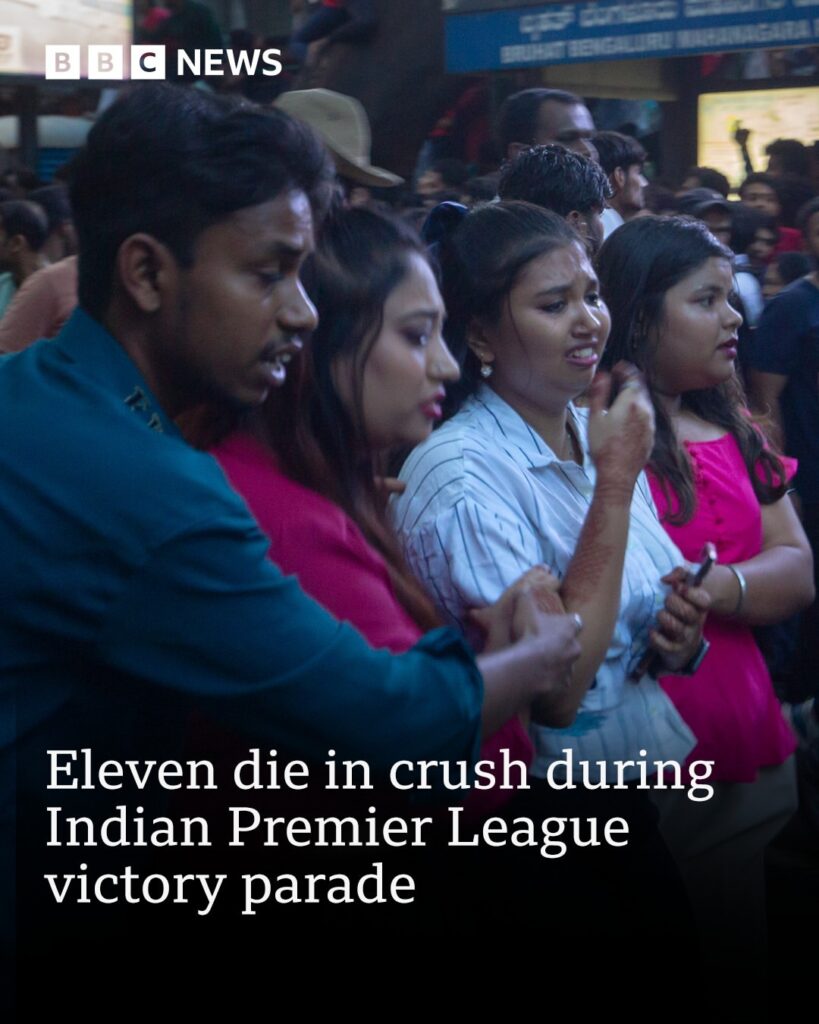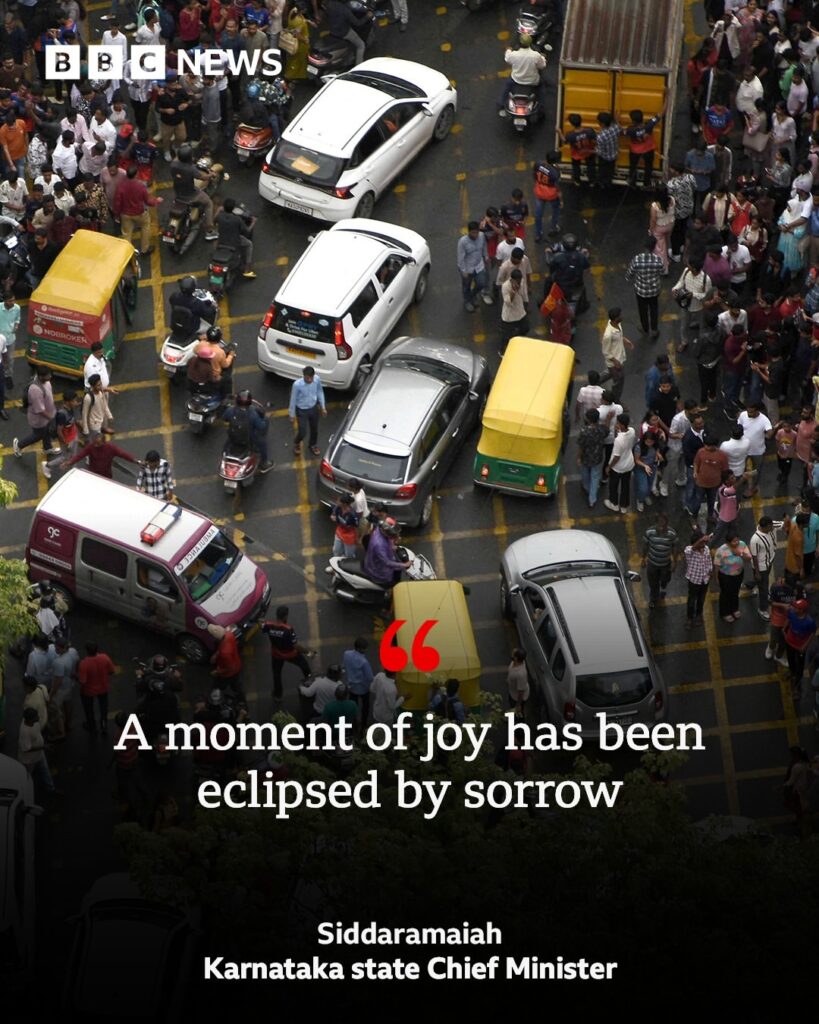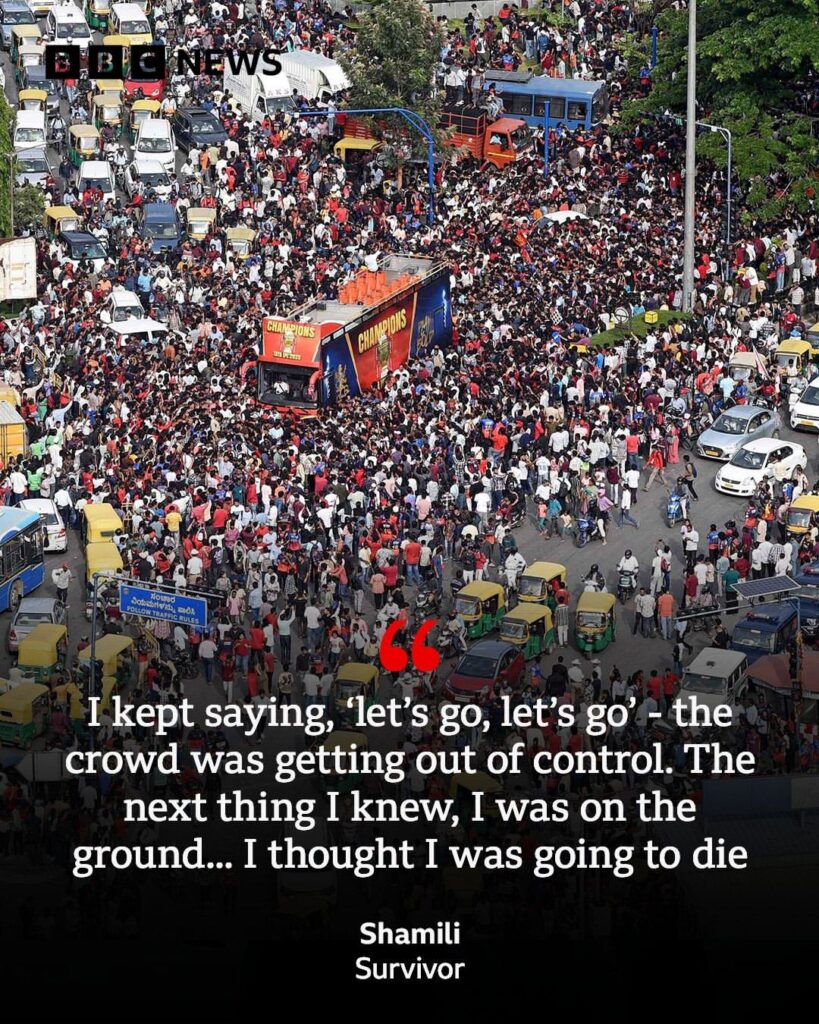
In a heartbreaking incident that has shaken the world of sports and cast a shadow over one of India’s most beloved pastimes, eleven people lost their lives in a crowd crush outside a cricket stadium in Bengaluru, India. The tragedy occurred ahead of a highly anticipated match at the iconic M. Chinnaswamy Stadium, where thousands had gathered hoping to witness history, but instead, the day turned into a nightmare.
According to authorities, the fatal crush took place as massive crowds surged at the stadium gates, trying to gain entry hours before the game was set to begin. Witnesses described the scene as chaotic, with inadequate security control and poor crowd management contributing to the disaster.
A Scene of Excitement Turned Tragic
The match — a marquee clash in the Indian Premier League (IPL) — had generated immense excitement, especially among local fans eager to see their team in action. Tickets had sold out within minutes online, prompting thousands of hopefuls to line up outside the stadium overnight, hoping for last-minute releases or gate entries. By morning, the crowd had swelled to several thousands, with tensions and anticipation rising.
Tragically, by mid-morning, the excitement gave way to panic.
“It started as pushing,” said Ravi Kumar, a survivor who was in line at the East Gate. “People behind were shouting and pushing forward. Then someone slipped, and people fell. After that, it was just screaming, people getting crushed. No one could breathe.”
Video footage captured by bystanders shows a sea of bodies pressed against barricades, with some people trying desperately to climb over barriers while others were pulled to safety by fellow fans. Security officials and volunteers can be seen attempting to control the flow, but it was far too late.
Confirmed Deaths and Injuries

As of the latest reports, eleven people have been confirmed dead, including two teenagers. Several others, including women and elderly fans, were hospitalized with injuries ranging from fractures to severe suffocation trauma. At least 40 people were treated at nearby medical facilities, with a handful in critical condition.
Karnataka state authorities have launched an investigation, promising full transparency and accountability. Bengaluru Police Commissioner B. Dayananda confirmed that a case has been registered, and a special task force has been formed to look into what went wrong.
Grief Across the Nation
As news of the tragedy broke, condolences poured in from across India and the global cricketing community. Prime Minister Narendra Modi expressed deep sorrow, tweeting:
“Extremely pained by the loss of lives in the tragic incident in Bengaluru. My thoughts are with the bereaved families. I pray for the recovery of those injured.”
Indian cricket captain Rohit Sharma also took to social media, saying:
“Cricket should never come at the cost of lives. This is devastating. We need to make our stadiums safer.”
Cricket fans, players, and journalists echoed the sentiment — what was meant to be a celebration of sport became a day of national mourning.
Questions About Safety and Management

In the aftermath, questions are being raised about event safety protocols at major sports venues in India. The M. Chinnaswamy Stadium, located in the heart of Bengaluru, has a capacity of around 40,000 and is known for its energetic atmosphere. But this incident has highlighted major gaps in how large crowds are handled.
“There were no proper barricades. No announcements. Just pushing,” said Meena Devi, who was at the venue with her teenage son. “We had no idea what was happening.”
Initial reports suggest that a shortage of entry gates, insufficient crowd marshals, and a lack of real-time communication led to bottlenecks at key access points. Ticket scalping and unauthorized entries may have also contributed to the overload.
Event organizers, including the Karnataka State Cricket Association (KSCA), have come under intense scrutiny. A press release issued late that evening expressed “deep sorrow” over the incident and promised internal reviews, but critics argue the warning signs were there.
A Pattern of Preventable Tragedies?

Unfortunately, this isn’t the first time India has faced deadly crowd surges. In recent decades, several religious festivals, political rallies, and public events have witnessed fatal stampedes due to similar lapses in planning and emergency response. The Bengaluru crush is now being compared to the 2008 Chamunda Devi temple stampede and the 2013 Allahabad train station tragedy during the Kumbh Mela.
Many experts say it’s time for India to adopt international crowd-control standards, especially as the country continues to host large-scale public events. “We need data-driven crowd modeling, better use of AI surveillance, and most importantly, coordination between civic authorities, police, and private event managers,” said Professor Rahul Saxena, a public safety analyst.
The Road Ahead

In the short term, the government has announced compensation for victims’ families: ₹10 lakh (approximately $12,000) for the families of the deceased, and ₹2 lakh for the injured. While this gesture is appreciated, activists argue it cannot replace lives — or erase the trauma endured.
Public outcry has already begun to affect the cricketing calendar. There are calls to either suspend matches temporarily at the Bengaluru venue or play behind closed doors until safety protocols are reevaluated and upgraded.
The BCCI (Board of Control for Cricket in India) has said it will meet with state authorities to review safety protocols at all remaining IPL venues. Whether this leads to long-term change remains to be seen.
Final Thoughts
Sport, at its best, brings people together. But when safety is compromised, joy turns into horror — as it did in Bengaluru.
Eleven lives have been lost, and families have been shattered, all because of a failure to anticipate the risks of mass gatherings. As India mourns, the hope is that this tragedy serves not only as a moment of grief but also as a catalyst for real, lasting reform in how public events are planned, managed, and secured.
Because no match — no matter how exciting — should ever cost a life.



